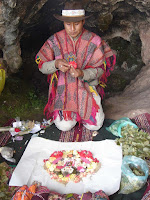 |
"Consciousness" by Sar Maroof
|
The works of Carl Jung, the Swiss psychiatrist and psychoanalyst, have profoundly influenced modern psychology and spiritual practice. His concepts of the collective unconscious, archetypes, and individuation resonate far beyond the confines of clinical therapy, inspiring movements rooted in spiritual exploration and self-discovery. Among these is the neo-shamanic movement, which integrates ancient shamanic practices with Jungian insights to create a path for healing, self-awareness, and connection to the greater whole. In this post, we'll delve into Carl Jung's contributions, explore the neo-shamanic movement, and discuss how these two areas intertwine to address modern existential challenges.
Understanding Carl Jung's Core Concepts
The Collective Unconscious and Archetypes
One of Jung's foundational ideas is the collective unconscious, a universal layer of the psyche shared by all humans. Unlike the personal unconscious, which houses individual experiences, the collective unconscious contains archetypes--primordial symbols and themes that manifest in myths, dreams, and cultural narratives. Examples of archetypes include:
- The Hero: Embarking on a transformative journey.
- The Shadow: Representing the darker, hidden aspects of the self.
- The Wise Old Man/Woman: Symbolizing guidance and wisdom.
For Jung, these archetypes serve as blueprints for human experience, shaping behaviors, emotions, and spiritual inclinations.
Individuation: A Journey of Wholeness
Jung emphasized the process of individuation, a journey of integrating various aspects of the self—conscious and unconscious—to achieve psychological wholeness. This quest for unity aligns with spiritual pursuits found in many ancient traditions, including shamanism.
What Is the Neo-Shamanic Movement?
Neo-shamanism is a contemporary adaptation of traditional shamanic practices, often blending indigenous wisdom with modern spiritual and psychological approaches. While traditional shamans are deeply embedded within specific cultural and tribal contexts, neo-shamans typically operate in more eclectic, globalized settings.
Key Elements of Neo-Shamanism
1. Altered States of Consciousness
Techniques like meditation, drumming, and breathwork help participants access altered states, akin to the shamanic trance, where they can explore their subconscious mind.
2. Healing Practices
Neo-shamanic rituals often focus on emotional and spiritual healing, using visualization, ceremony, and energy work to restore balance.
3. Connection to Nature
Emphasizing a deep relationship with the natural world, neo-shamanism promotes ecological awareness and reverence for the interconnectedness of life.
4. Global Adaptability
Unlike traditional shamanism, which is often localized, neo-shamanism incorporates elements from various cultures, making it accessible to diverse practitioners.
The Intersection of Jungian Psychology and Neo-Shamanism
Jung's ideas are naturally aligned with shamanic principles. Both frameworks recognize the profound power of symbols, dreams, and altered states of consciousness in facilitating transformation and healing.
Archetypes as Spiritual Guides
In neo-shamanic practice, archetypes play a central role. Participants often work with archetypal energies--such as the Warrior, Mother, or Healer--during rituals or meditative journeys. These figures serve as guides, helping individuals confront personal challenges or uncover hidden potentials.
For example, the archetype of the Shadow is particularly significant. By facing and integrating one's Shadow, neo-shamanic practitioners aim to overcome fears, unresolved traumas, and suppressed desires--mirroring Jung's emphasis on embracing the unconscious.
Altered States and the Psyche
Jung viewed altered states of consciousness as gateways to the unconscious. His own experiences with active imagination--a technique of consciously engaging with inner images--paralleled shamanic journeys. Neo-shamanism adopts similar practices, using tools like drumming or plant medicine to facilitate introspection and healing.
Individuation as a Modern Vision Quest
The shamanic vision quest--a spiritual journey undertaken for insight or renewal--aligns closely with Jung's individuation process. Both paths seek to harmonize internal conflicts, foster self-awareness, and connect the individual with a greater cosmic or spiritual order.
Relevance in the Modern World
The convergence of Jungian psychology and neo-shamanism offers a profound response to the alienation and existential crises of contemporary life. By addressing the spiritual and psychological dimensions of the human experience, these practices provide tools for navigating modern challenges.
Benefits of Integrating Jungian and Shamanic Approaches
1. Healing Trauma
Both frameworks address trauma at a deep level, using symbolic and experiential methods to process and transform pain.
2. Cultivating Meaning
Archetypal narratives and rituals provide a sense of purpose and connection, countering the disconnection many feel in a materialistic society.
3. Fostering Ecological Awareness
Neo-shamanism's reverence for nature resonates with the current need for ecological consciousness, encouraging sustainable practices and harmonious living.
4. Empowering Personal Growth
By exploring the unconscious and integrating its lessons, individuals can achieve a greater sense of self-awareness and empowerment.
Criticisms and Ethical Considerations
While the integration of Jungian ideas and shamanic practices holds great promise, it is not without criticism. Cultural appropriation remains a significant concern, as neo-shamanism often borrows rituals and symbols from indigenous traditions without proper respect or understanding. Practitioners and seekers must approach these practices with humility, authenticity, and a commitment to honoring the origins of shamanic knowledge.
Conclusion
Carl Jung's psychological theories and the neo-shamanic movement share a deep affinity, both striving to heal the human spirit and connect individuals to a greater whole. By bridging ancient wisdom with modern insight, they offer a transformative path for those seeking balance, meaning, and renewal.
As interest in these practices continues to grow, they hold the potential to address not only individual healing but also collective challenges, from ecological crises to societal disconnection. Whether through introspection, ritual, or connection with nature, the union of Jungian psychology and neo-shamanism invites us to embark on a journey toward wholeness and harmony.





